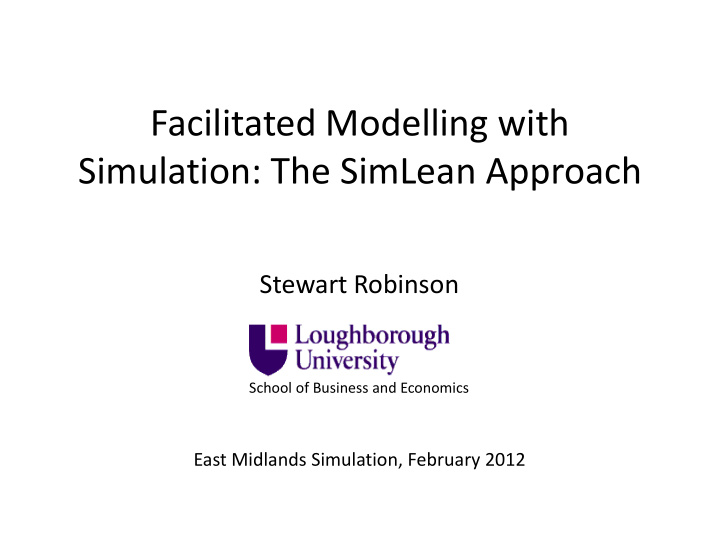



Facilitated Modelling with Simulation: The SimLean Approach Stewart Robinson School of Business and Economics East Midlands Simulation, February 2012
Facilitated Modelling Franco and Montibeller [2010] Expert Mode Facilitated Mode Sporadic client involvement Clients involved throughout Problem is real entity Problem is socially constructed Analysis needs to be objective Subjectivity is inevitable Optimal solutions wanted Satisficing solutions wanted Implementation follows from Implementation follows from scientific rigour participation in the study 2
Previous Attempts at Facilitated Modelling with DES Robinson (2001): user support help desk Adamides and Karacapilidis (2006): collaborative business process modelling den Hengst et al (2007): cargo flows at a Dutch airport Tako et al (2010): PartiSim Barjis (2011): collaborative, participative and interactive modelling 3
SimLean SimLean Lean event Educate Evaluate SimLean Facilitate During Before After
SimLean Facilitate
SimLean Facilitate - Ophthalmology Clinic Lengthy waits Doctors arrive late for clinics Nurses and admin. Staff overworked Low morale
Lean Improvement Workshop Step 1 – Go to the Gemba: go see/experience the place where the work is done Time Activity Duration 10.40 Arrive at reception, no wait 10.40 - 11.07 Wait in waiting room 1 (waiting room full) 27 11.07 Called for visual test, asked to read letters 0.5 11.08 Walk round to waiting room 2 0.5 11.09 - 12.07* Wait in second waiting room (waiting room full) 58 12.07 - 12.20 Visual fields test 13 12.20 - 12.45 Wait (in waiting room 2) 25 12.45 Patient called, but she reports she has already had the scan 0.5 12.46 - 13.05 Patient returns to waiting room 2 and waits 19 13.05 - 13.10 Patient with Doctor 5 Patient goes to reception and there is now a queue… 13.10 Total time in system 148.5 Total time waiting 129 Total time in activity 19.5
Lean Improvement Workshop Step 2 – Map the Process
Lean Improvement Workshop Step 3 – Build the Model Rapidly
Lean Improvement Workshop Step 4 – Demonstrate and Discuss the Model (Day 2) 1. Model Understanding: what is the model doing? 2. Face Validation: does this look like what happens in the ophthalmology clinic? 3. Problem Scoping: what is causing the problems in the ophthalmology clinic? 4. Improvement: what could we do about it?
Lean Improvement Workshop Step 5 – Conduct Rapid Experiments to Test ‘What if’. Patients here are waiting for a doctor. – increased accountability Patients needing a Visual Field Test also have their Vision Test
Lean Improvement Workshop The Outcome Actual physical measurements were taken of the treatment rooms to ensure that the vision test equipment could fit into the visual field test rooms ‘It is good to see it [the process] pictorially... doctors don’t see the effect on patients.’ ‘we talked a lot more about the model than about the map on day 1.’ ‘The simulation was the turning point in the discussion.’
Is This Facilitated Modelling? Client involvement Low Medium High Conceptual modelling Data collection and analysis Verification and validation Expert to facilitated mode gap Model coding PF to facilitated mode gap Experimentation Implementation Expert mode Pseudo-facilitated (PF) mode Facilitated mode 13
Requirements for Rapid Modelling Model Element Detail Complexity Entities Arrivals Time based profile or appointment based Early/late/do not attend Batched arrivals Attributes Patient type First/repeat patient Priority Queues Capacity Queue FIFO, LIFO, By attribute discipline/priority Minimum time in Specify distribution queue Activities Number of Time Specify distribution or by patient type Routing Percentage or by attribute Distributions Types Fixed Negative exponential Triangle 14
Closing the Gap The answer is not technological e.g. model reuse Change of modelling worldview to: • Problem is socially constructed • Subjectivity is inevitable • Satisficing solutions wanted • Implementation follows from participation in the study Avoid detailed complexity Develop simple, low fidelity models with the client 15
Closing the Gap Where technology might help Computer supported Automatic generation of group process mapping simulation Computer supported group data estimating 16
www.simlean.org
Recommend
More recommend